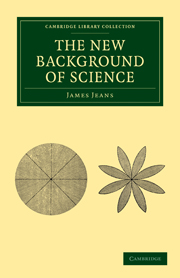Book contents
- Frontmatter
- Contents
- Preface to the First Edition
- Preface to the Second Edition
- Chapter I The Approach to the External World
- Chapter II The Methods of Science
- Chapter III The Framework of the External World—Space and Time
- Chapter IV Mechanism
- Chapter V The Texture of the External World—Matter and Radiation
- Chapter VI Wave-Mechanics
- Chapter VII Indeterminacy
- Chapter VIII Events
- Index
Chapter IV - Mechanism
Published online by Cambridge University Press: 07 September 2010
- Frontmatter
- Contents
- Preface to the First Edition
- Preface to the Second Edition
- Chapter I The Approach to the External World
- Chapter II The Methods of Science
- Chapter III The Framework of the External World—Space and Time
- Chapter IV Mechanism
- Chapter V The Texture of the External World—Matter and Radiation
- Chapter VI Wave-Mechanics
- Chapter VII Indeterminacy
- Chapter VIII Events
- Index
Summary
Action at a Distance
Primitive man saw nature as a collection of objects which acted on one another, if at all, by direct contact; he was familiar with the pressure of wind and water on his body, the fall of raindrops on his skin, the thrust by an enemy, but action at a distance was somewhat of a rarity in his scheme of things.
Early science hardly advanced on this view, picturing matter as consisting of hard objects, no two of which could occupy the same space because one invariably pushed the other out of the way by direct contact. The science of a later era, however, found many instances of action at a distance. A magnet attracts iron filings to itself from a distance, and is itself acted on by the yet more distant magnetic poles of the earth; two electrified bodies attract or repel one another across the intervening space according as they are charged with opposite or similar kinds of electricity; the sun attracts the planets, and the earth the falling apple. In none of these cases can anything tangible be found to transmit the attractions and repulsions. It is true that the space between the interacting objects will often be occupied by air, but this does not transmit the action; electrified bodies and magnets attract rather more forcibly in a perfect vacuum than in air, while an apple falls more freely and rapidly when there is no air-resistance to break its fall.
- Type
- Chapter
- Information
- The New Background of Science , pp. 115 - 150Publisher: Cambridge University PressPrint publication year: 2009First published in: 1931



